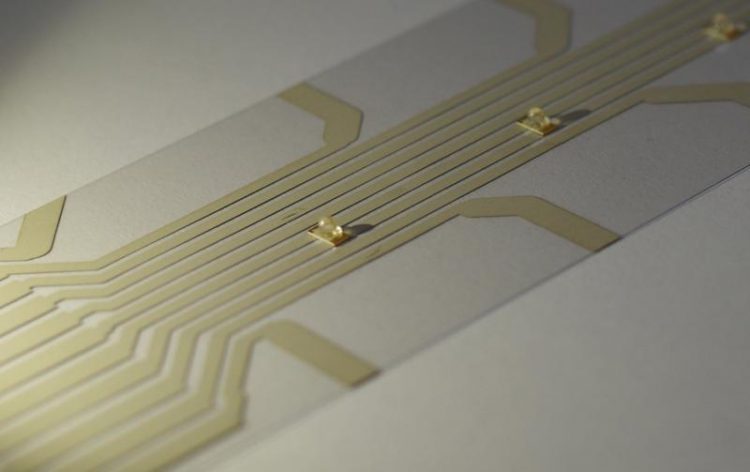ILA 2018: Automated lightweight construction reduces weight and costs

The Fraunhofer ENAS manufactures printed circuit boards in screen printing on a flexible plastic film. The tracks transmit electrical impulses – for example, to make LEDs glow. Fraunhofer ENAS
Like veins in the human body, copper cables run through the fuselage of aircrafts. They transmit electrical signals for temperature-measuring sensors, LEDs in ceilings or electronic connections in seats. During their installation, individual cables are combined into harnesses. “The process of producing and installing cable harnesses is currently 100 percent manual.
This is very time-consuming and expensive,“ says Dr. Ralf Zichner. He is head of the Printed Functionalities department at the Fraunhofer Institute for Electronic Nano Systems ENAS in Chemnitz, Germany and works together with his research team on manufacturing processes that automatically print electrical conductors directly onto aircraft components. The advantages: There is no waste during production, the print templates can be adapted quickly and flexibly, the classic laying of the cable harnesses is eliminated and the aircraft manufacturers save space and weight.
Printing cable harnesses easily
“We use electrically conductive silver ink, which we apply by screen or inkjet printing in layers of only a few microns directly onto lightweight aerospace materials, such as high temperature resistant plastics,“ explains Zichner.
In addition to the use of printing technologies for the production of printed conductors, the Chemnitz scientists also integrate microcontrollers, diodes, capacitors, resistors and other electronic components into aerospace modules. Ink and printing processes have to be optimally matched to the materials on which the printing is to occur. The Fraunhofer ENAS has extensive expertise regarding these processes, especially in terms of aerospace requirements. The technology is about to be launched. It is currently being optimized in the Fraunhofer “Go Beyond 4.0“ Lighthouse Project.
Economical production with thermoplastics
An example of aviation-grade plastics are high-temperature resistant thermoplastics. They are an important component of lightweight, stable fiber reinforced plastics (FRP), which are indispensable in the construction of aircraft. Thermoplastics can be reshaped or formed in a specific temperature range; they also cool down quickly after processing and can be processed at a fast pace. In addition, they are impressive due to their good flame resistance and the possibility of functional integration.
“In aviation, though, there has previously been a lack of concepts for the cost-effective production of functionally integrated thermoplastic structures,“ notes Tobias Joppich of the Polymer Engineering/Thermoplastics Processing Department at the Fraunhofer Institute for Chemical Technology ICT in Pfinztal, Germany.
Together with partners in the LuFo V-1 program, the research institute has taken an important step towards exploiting the potential of thermoplastics in the construction of aircrafts. Together, they have developed a new component and production concept with modular stiffening elements that is specially adapted to cargo holds. The lightweight construction experts produce these from fiber-reinforced high-temperature thermoplastics in a hybrid molding process, a combination of forming and injection molding processes.
The lightweight components are flame retardant, stable, can be automated in large quantities and are easy to assemble: they are just put together. “This allows manufacturers to quickly stiffen interior walls of cargo holds according to a flexible design,“ says Joppich. The stable grid structure is then attached by laser transmission welding to the inner wall of the cargo hold. The new concept from the Baden-based company can also be applied to other aircraft components, including the body shell, clips or internal components, such as seat structures. Hybrid material combinations can also be realized by the Fraunhofer ICT.
https://www.fraunhofer.de/en/press/research-news/2018/april/automated-lightweigh…
Media Contact
All latest news from the category: Materials Sciences
Materials management deals with the research, development, manufacturing and processing of raw and industrial materials. Key aspects here are biological and medical issues, which play an increasingly important role in this field.
innovations-report offers in-depth articles related to the development and application of materials and the structure and properties of new materials.
Newest articles

Properties of new materials for microchips
… can now be measured well. Reseachers of Delft University of Technology demonstrated measuring performance properties of ultrathin silicon membranes. Making ever smaller and more powerful chips requires new ultrathin…

Floating solar’s potential
… to support sustainable development by addressing climate, water, and energy goals holistically. A new study published this week in Nature Energy raises the potential for floating solar photovoltaics (FPV)…

Skyrmions move at record speeds
… a step towards the computing of the future. An international research team led by scientists from the CNRS1 has discovered that the magnetic nanobubbles2 known as skyrmions can be…





















